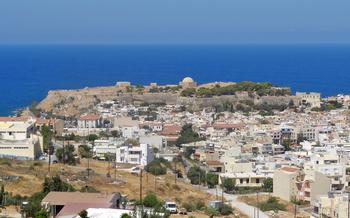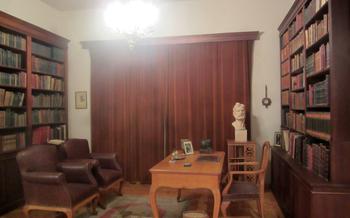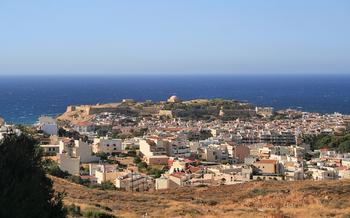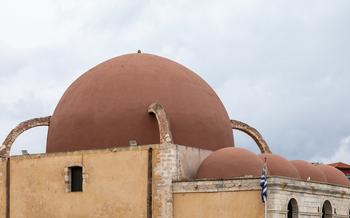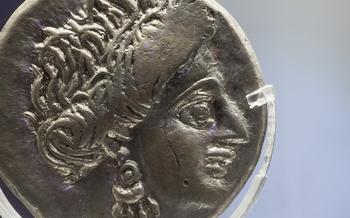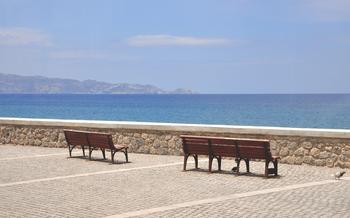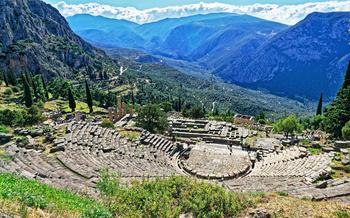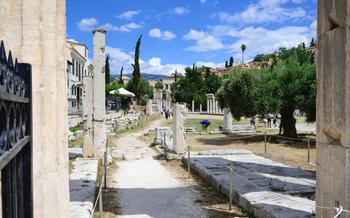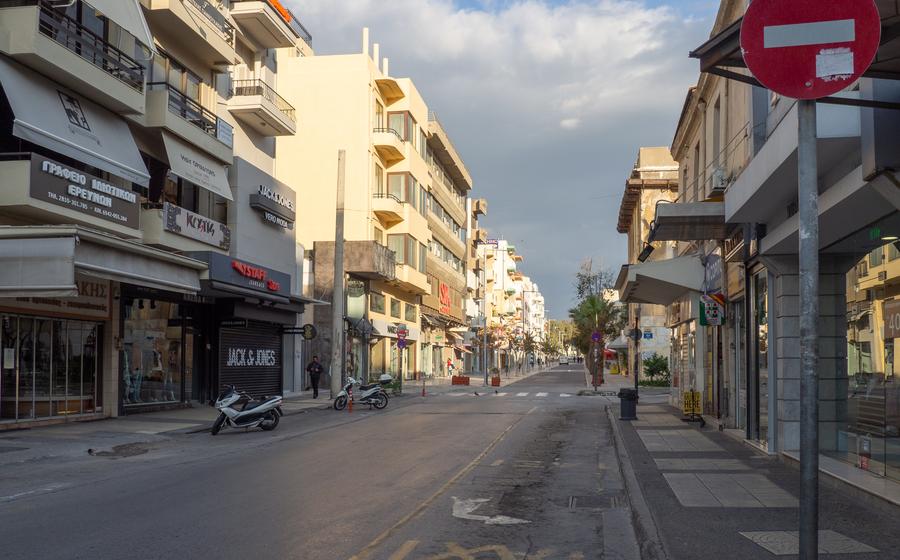
Gortyna Archaeological Site
- Exploring the Ancient City
- Notable Archaeological Finds
- The Roman Agora: A Place of Commerce and Community
- The Early Christian Basilica
- The Village of Gortyna
- Planning Your Visit
- Getting to Gortyna
- Practical Tips for Visitors
- Nearby Attractions
- Local Cuisine and Restaurants
- Insider Tip: Gortyna Festival
Exploring the Ancient City
As you step through the ruins of Gortyna, you will encounter remnants of the city walls, gates, and streets that once defined its boundaries. These fortifications, constructed with massive stone blocks, testify to the city's strategic importance and the need for protection from potential invaders.
Within the city walls, you will discover residential areas where ordinary Gortynians lived and worked. These dwellings, often clustered together, provide glimpses into the daily lives of the city's inhabitants. Public buildings, such as administrative offices and meeting halls, stand as testaments to the organized governance of Gortyna.
Temples, theaters, and other structures speak to the cultural and religious life of the ancient city. The Temple of Apollo Pythios, dedicated to the Greek god Apollo, is a particularly notable example, with its impressive architectural features and remnants of its once-grand statues. The Odeon of Gortyna, a small theater for musical performances, offers a glimpse into the cultural pursuits of the city's residents.
Notable Archaeological Finds
Among the most significant archaeological finds at the Gortyna Archaeological Site are the Gortyn Code, a renowned law code inscribed on stone tablets in the 5th century BC. This code governed various aspects of life in ancient Gortyn and is considered a valuable source of information about the legal system and society of the time.
The site has also yielded numerous statues and sculptures from various periods, including the Archaic, Classical, and Hellenistic eras. These works of art depict gods, goddesses, heroes, and everyday people, providing insights into the religious beliefs, artistic styles, and cultural influences of ancient Gortyn.
Additionally, excavations have uncovered pottery, jewelry, tools, weapons, and other artifacts that shed light on the daily lives and activities of the city's inhabitants. These artifacts range from simple household items to elaborate decorative pieces, offering a glimpse into the material culture and craftsmanship of ancient Gortyn.
The Roman Agora: A Place of Commerce and Community
The Roman Agora, situated at the heart of ancient Gortyna, served as a bustling marketplace and a focal point for social interactions. This central square, typical of Roman urban planning, was surrounded by a colonnade of shops, temples, and other public buildings. The agora was the epicenter of trade and commerce, where merchants displayed their wares, farmers sold their produce, and locals bartered for goods. Coins, pottery fragments, and other artifacts unearthed during excavations provide glimpses into the economic activities that took place in this vibrant marketplace. It is easy to imagine the lively atmosphere of the agora, filled with the sounds of haggling, the clinking of coins, and the laughter of people coming together to conduct business and socialize. The Roman Agora stands as a testament to the commercial and communal importance of this ancient city.
The Early Christian Basilica
In the heart of the Gortyna Archaeological Site, visitors can marvel at the remains of an early Christian basilica, a testament to the city's rich religious history. Constructed during the early Byzantine period, this impressive structure showcases the transition from paganism to Christianity in Gortyna.
The basilica's grand dimensions and intricate architectural features speak to its significance as a religious center. Its spacious interior was divided into three aisles by rows of columns, creating a sense of grandeur and solemnity. The apse, the semicircular recess at the eastern end of the basilica, once housed the altar and was adorned with intricate mosaics.
Although time and natural disasters have taken their toll, the basilica's ruins still evoke its former glory. Visitors can admire the remnants of the mosaic floors, which depict biblical scenes and geometric patterns. These mosaics, with their vibrant colors and intricate designs, provide a glimpse into the artistic and religious expressions of the early Christian community in Gortyna.
The Early Christian Basilica stands as a poignant reminder of the city's deep-rooted spiritual traditions and the enduring legacy of Christianity in the region. Its presence within the archaeological site adds another layer to Gortyna's rich and multifaceted history.
The Village of Gortyna
Nestled close to the archaeological site, the village of Gortyna welcomes visitors with its quaint charm and traditional Cretan vibes. Stroll along the narrow, winding streets adorned with whitewashed houses, blooming bougainvillea, and small shops selling local crafts and souvenirs. Experience the hospitality of the locals, immerse yourself in their customs, and savor the authentic flavors of Cretan cuisine at the village tavernas. Don't miss the chance to visit the Folk Art Museum, showcasing the rich cultural heritage of the region through displays of traditional costumes, pottery, and agricultural tools. Gortyna village is a living testament to the harmonious blend of ancient history and modern-day Cretan life, offering a delightful respite from exploring the archaeological treasures.
Planning Your Visit
Best Time to Visit
The best time to visit the Gortyna Archaeological Site is during the shoulder seasons, from April to May and from September to October. During these months, the weather is pleasant, with warm days and cool nights. Crowds are also smaller, making it easier to explore the site at your own pace.
Recommended Duration of Visit
While you can see the highlights of the site in a few hours, it's recommended to dedicate at least half a day to fully appreciate its history and grandeur. This will give you enough time to explore the main attractions, such as the Temple of Apollo Pythios, the Odeon, and the Roman Agora, as well as wander through the ancient streets and residential areas.
Guided Tours and Self-Exploration Options
Guided tours are available at the site, providing valuable insights into the history and significance of Gortyna. These tours typically last around 1-2 hours and are led by knowledgeable guides. However, if you prefer to explore at your own pace, there are also self-guided options. The site is well-signposted, and there are information boards at each attraction.
Getting to Gortyna
Gortyna's archaeological site is situated about 45 kilometers south of Heraklion, the capital of Crete. Reaching Gortyna is relatively easy, with several transportation options available.
For those without their own vehicle, the most convenient way to get to Gortyna is by bus. KTEL buses depart regularly from Heraklion's main bus station, located near the port, and take approximately 1 hour and 15 minutes to reach Gortyna. Buses also run from other cities in Crete, such as Rethymno and Chania, but may require a transfer in Heraklion.
If you prefer the flexibility of driving, Gortyna can be reached by car from Heraklion in about 50 minutes. Take the National Road towards Phaistos and follow the signs for Gortyna. Once you arrive in the village, follow the signs to the archaeological site. Parking is usually available near the site's entrance.
Practical Tips for Visitors
When visiting the Gortyna Archaeological Site, it is essential to consider a few practical tips to ensure a comfortable and enjoyable experience.
-
Comfortable Footwear: The site involves walking on uneven terrain, so wearing comfortable shoes with good support is crucial.
-
Sun Protection: Crete is known for its sunny weather, so sunscreen, a hat, and sunglasses are essential to protect yourself from the sun's harmful rays.
-
Hydration: Bring plenty of water, especially during the hot summer months, to stay hydrated while exploring the site.
-
Respect the Site: Remember that the Gortyna Archaeological Site is a protected historical site. Respect the artifacts and structures by refraining from touching, climbing, or damaging them in any way.
-
Photography: Photography is generally allowed at the site, but it is essential to be mindful of other visitors and avoid using flash photography, especially in enclosed spaces.
-
Guided Tours: Guided tours are available for those who want a more in-depth understanding of the site's history and significance.
-
Self-Exploration: For those who prefer to explore at their own pace, self-guided tours are also possible. Maps and guidebooks are available at the site's entrance.
-
Accessibility: The site is generally accessible to visitors with disabilities, but some areas may be challenging to navigate due to uneven terrain. Wheelchairs are available upon request.
-
Facilities: Limited facilities are available at the site, so it is advisable to bring any necessary items, such as snacks, drinks, or first-aid supplies.
Nearby Attractions
In addition to the archaeological site, the region surrounding Gortyna offers a variety of other attractions that are worth exploring.
Phaistos Palace: Located about 11 kilometers southwest of Gortyna, Phaistos was one of the most important Minoan palaces on Crete. The palace dates back to the Bronze Age and is known for its impressive architecture, including the Grand Staircase and the Royal Apartments.
Matala Beach: Just a short drive from Gortyna, Matala Beach is a picturesque stretch of coastline with golden sands and crystal-clear waters. The beach is famous for its caves, which were once inhabited by hippies in the 1960s.
Agia Triada Monastery: Situated about 15 kilometers west of Gortyna, Agia Triada Monastery is a historic monastery that dates back to the 14th century. The monastery is renowned for its beautiful architecture, including the intricate frescoes and mosaics that adorn its walls.
Local Cuisine and Restaurants
When visiting Gortyna, don't miss the opportunity to savor the delicious flavors of traditional Cretan cuisine. Indulge in dishes like dakos, a refreshing salad made with barley rusks, tomatoes, cucumbers, and feta cheese. Try gamopilafo, a hearty rice dish with lamb or chicken, cooked in a rich tomato sauce and topped with kefalotyri cheese. For seafood lovers, grilled octopus and fresh fish are must-try dishes.
In Gortyna village, you'll find several tavernas and restaurants offering authentic Cretan cuisine. Look for places with outdoor seating, where you can enjoy your meal while basking in the warm Mediterranean sun. For an unforgettable dining experience, head to one of the family-run tavernas in the nearby villages, where you'll be treated to homemade dishes prepared with fresh, local ingredients.
Some recommended restaurants in Gortyna and the surrounding area include:
-
To Steki tou Ilia: A traditional taverna serving classic Cretan dishes in a cozy atmosphere.
-
O Thanasis: A family-run restaurant known for its delicious grilled meats and seafood.
-
To Kafeneion tou Horiou: A charming cafe-restaurant located in the heart of Gortyna village, offering a variety of Cretan specialties and homemade desserts.
Remember to pair your meal with a glass of local wine, such as the renowned Dafni or Kotsifali varieties, to complete your culinary journey through Crete.
Insider Tip: Gortyna Festival
For an immersive experience of Gortyna's history and culture, plan your visit during the annual Gortyna Festival. Held typically in the summer months, this lively festival brings the ancient city to life with a variety of events and performances. Witness traditional Cretan dances, listen to live music concerts, and participate in workshops on local crafts and customs. The festival also features exhibitions, theatrical performances, and reenactments that showcase the rich heritage of Gortyna. Immerse yourself in the vibrant atmosphere as you explore the archaeological site and engage with local artisans and performers. The Gortyna Festival is not just a celebration of the past but a testament to the enduring spirit of this ancient city.
